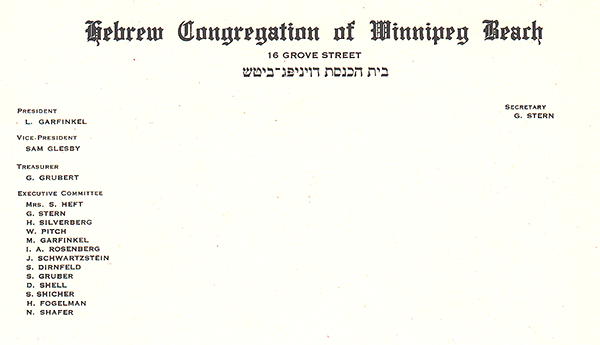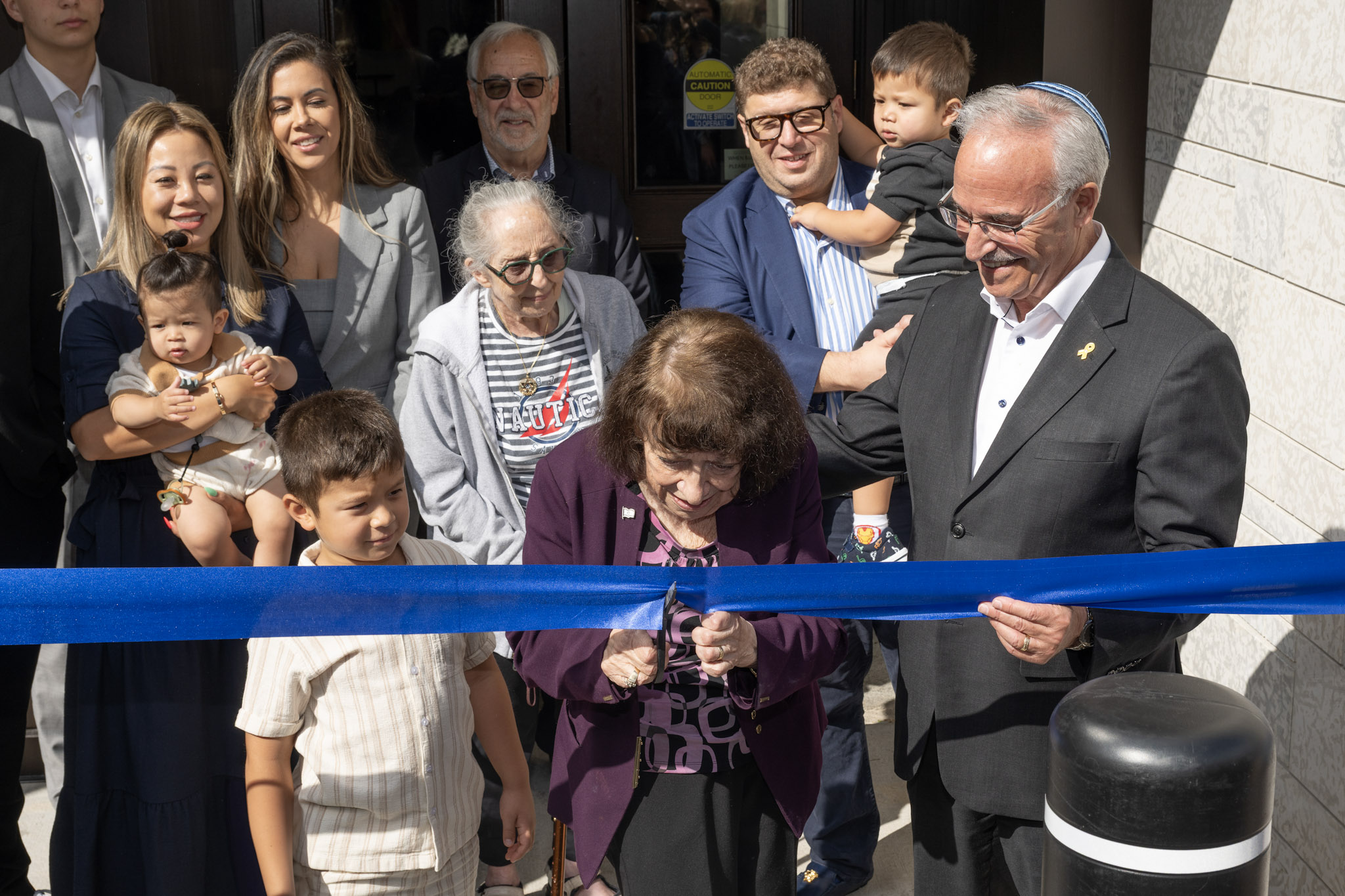Local News
Jewish teams once again among Cancercare Manitoba Foundation Challenge for Life top fundraisers
 By MYRON LOVE The 15th annual Cancercare Manitoba Foundation Challenge for Life 20KM walk (or 200-minute workout) is back again, but much later this year than had traditionally been the case: August 4-14. Once again, teams dominated or led by members of our Jewish community are among the top fundraisers.
By MYRON LOVE The 15th annual Cancercare Manitoba Foundation Challenge for Life 20KM walk (or 200-minute workout) is back again, but much later this year than had traditionally been the case: August 4-14. Once again, teams dominated or led by members of our Jewish community are among the top fundraisers.
Over the years, Benji Harvey, one of the “Greenfeld girls”, has consistently proven herself to be one of the event’s star fundraisers. This year, for the first time, the prolific Harvey sits in first place (as of the middle of July) having personally raised just over $11,000 – almost $2,000 more than the next closest participant (whose last name also coincidentally happens to be Harvey, although the two fundraisers are not related) – with more than double the total value of donations that she brought in last year.
Benji Harvey’s Team Shvesters has raised just under $18,000 for this year’s Challenge – also more than double last year’s total – and good for third place among fundraising teams. So far,
Since the beginning of the Challenge for Life, Team Shvesters has raised a total of more than $260,060, with Benjii Harvey accounting for just under $64,000 (including donations received as of mid-July this year).
The team was founded by Harvey and her sisters, Lesly Katz and Debby Lewis. Two of the sisters had been diagnosed with breast cancer.
This year, Harvey notes, the team members are Benji, Lesly, Deb and Kim Gray (who ranks ninth among individual fundraisers with close to $4,000 raised).
As was the case the last two years, participants this year are walking in small groups covering the same 20km distance that used to be the goal on the day of the walk pre-Covid, but over two weeks from August 4 to 14.
Team Shvesters members will be doing the walk on Saturday, August 6, following a route that takes them through Assiniboine Park, Charleswood, Academy Road and Wellington Crescent and back to the park and finishing with a 30 minute yoga stretch.
In fourth place among team fundraisers this year is another “Jewish” team that has consistently been among the top ten over the years. As of mid-July, Nancy’s Nightingales – consisting of longtime friends Louise Raber (team captain), Harriet Lyons, Joanne Katz and Connie Botelho and relative newcomer Rhonda Youell (this is her fourth year as part of the team) – have raised over $11,250.
Lyons’ $4,300 raised puts her in seventh place amongst individual fundraisers.
The“Nightingales” were named after a nurse – a cancer survivor – who is a friend of Louise Raber – and have been part of the Challenge for Life since its inception 16 years ago..
Raber notes that the team will be doing the virtual 20km walk over two days beginning at the Shaarey Zedek parking lot, following a route down Wellington Crescent to Assiniboine Park and back again.
Jason’s Journey, a team led by Jason Gisser, will be doing their walk on August 7 following a route that encompasses Tuxedo, River Heights and Crescentwood. Gisser reports that the team will also he holding an event on August 6 with family members of the participants encouraged to join.
The son of David Gisser and Freda Steel has experienced a more intimate and longer-lasting relationship with cancer than many of the other Challenge for Life participants. He was first diagnosed with cancer when he was 18. The still young lawyer has been fighting cancer for more than half his life now. Happily, an oral chemotherapy pill he has been taking for the past few years has controlled his cancer and allowed him to return to living a normal life.
He first took up the Challenge in 2019 as a way to give back for all the help that he has received over the years from CancerCare Manitoba staff. This year, thus far, he has personally brought in over $5,000 – the fifth most among individual entrants – while his team – also consisting of Matthew Maruca, Wendy Martin White and Nora Fien – has raised over $8,000 – good for fifth place overall among teams.
The oldest participant in the Challenge once again is 88-year-old Pearl Rosenberg who, with her daughters, Cindy Yusim and Brenda Dahle, comprise Sister Act.
Rosenberg lost two daughters to cancer within about a year of each other. Naomi Palansky passed away in 2010 and Michelle Moyer in 2011. Brenda Dahle notes that Naomi walked with her family in the first Challenge For Life Walk.
(And readers may recall that Naomi’s children, Noah and Lexi, started their own team of walkers, “Kids Count,” shortly after their mother received her cancer diagnosis.)
“I started taking part in the Challenge for Life on Team Chai in 2008,” Dahle says. “My mom, my sister Cindy, and I walk in memory of our sisters whose love, strength, and courage continue to inspire us.” Dahle reports that her mother’s walk will be incorporated into her daily walks in Kildonan Park – doing the 20km in increments of 3-5 km a day over six or seven days.
“We hope to raise at least $2,500 each,” Dahle says.
Perennial fundraising dynamo Serratus Superstars have also been walking the Challenge for Life since the Challenge inception in 2008. Team captain Cathy Moser reported in an interview with the JP&N last year that the group had raised over $450,000.00 in those years – through donations, garage sales, concerts, and bake sales.
For this year, Moser is still looking to recruit more team members. Interested readers can email Cathy Moser at cathy.g.moser@gmail.com.
Senior Provincial Court Judge Rocky Pollack is another perennial participant in the Challenge for Life. Pollack’s wife, Sharon, fought cancer for 14 years before her passing in 2012. During the time that she was ill, both Sharon and Rocky came to appreciate the care that she received from Cancercare Manitoba and they both became actively involved in the organization and the foundation. Rocky has served in a number of positions with the organization over the years and has participated in the Challenge for Life for the last several years as well.
Two years ago, Pollack and his Team No Judgment (which included twelve of his colleagues) raised just under $6000. “Our goal is to raise more money than last year,” he says. “Community outreach is important to all of the judges of my court. They get involved in several ways and I am proud to say that the CancerCare Foundation is again one of them.”
Readers can make donations to their preferred team by going online to CancerCarefdn.mb.ca and clicking on Challengeforlife.ca.
Local News
Thank you to the community from the Chesed Shel Emes

We’re delighted to share a major milestone in our Capital Campaign, “Building on our Tradition.” Launched in November 2018, this campaign aimed to replace our outdated facility with a modern space tailored to our unique needs. Our new building is designed with ritual at its core, featuring ample preparation space, Shomer space, and storage, creating a warm and welcoming environment for our community during times of need.
We’re grateful to the nearly 1,000 generous donors who contributed over $4 million towards our new facility. A $750,000 mortgage will be retired in November 2025, completing this monumental project in just seven years.
We’re also thrilled to announce that our Chesed Shel Emes Endowment Fund has grown tenfold, from $15,000 to $150,000, thanks to you, the Jewish Foundation of Manitoba’s FundMatch program, and Million Dollar Match initiative in 2024. Our fund helps ensure that everyone can have a dignified Jewish funeral regardless of financial need.
As we look to the future, our goal remains to ensure the Chevra Kadisha continues to serve our community for generations to come. Our focus now shifts to replenishing our savings account and growing our JFM Endowment fund.
We’re deeply grateful for your support over the past several years.
It’s our privilege to serve our community with care and compassion.
With sincere appreciation,
Campaign cabinet: Hillel Kravetsky, Gerry Pritchard, Stuart Pudavick,
Jack Solomon, and Rena Boroditsky
Murray S. Greenfield, President
Local News
Winnipeg Beach Synagogue about to celebrate 75th anniversary

By BERNIE BELLAN (July 13) In 1950 a group of cottage owners at Winnipeg Beach took it upon themselves to relocate a one-room schoolhouse that was in the Beausejour area to Winnipeg Beach where it became the beach synagogue at the corner of Hazel and Grove.
There it stayed until 1998 when it was moved to its current location at Camp Massad.
On August 2nd members of the synagogue will be holding a 75th anniversary celebration.

As part of the celebration anyone who is a descendant or relative of any of the original members of the first executive committee (as seen in the photo here) is invited to attend the synagogue that morning.
If you are a relative please contact Abe Borzykowski at wpgbeachshule@shaw.ca or aborzykowski@shaw.ca to let Abe know you might be attending or for more information about the 75th anniversary celebration.
We will soon be publishing a story about the history of the beach synagogue, which is something I’ve been writing about for over 25 years.
Local News
Vickar Family cuts ribbon on new Tova Vickar and Family Childcare Centre

By MYRON LOVE In the words of Larry Vickar, the Shaarey Zedek’s successful Dor V’ Dor Campaign “is not only a renewal of the synagogue but truly a renewal movement of Jewish life in our community.”An integral part of that renewal movement was the creation of a daycare centre within the expanded synagogue. On Monday, June 23, Larry and Tova Vickar cut the ribbon, thereby officially opening the Tova Vickar and Family Childcare Centre in the presence of 100 of their family members, friends and other supporters of the project.
The short program preceding the morning ribbon-cutting began with a continental breakfast followed by a welcome by both Fanny Levy, Shaarey Zedek’s Board President, and Executive Director Dr. Rena Secter Elbaze. In Elbaze’s remarks, she noted that Larry and Tova wanted their family (including son Stephen and family, who flew in from Florida) and friends at the event to celebrate the opening of the Tova Vickar and Family Childcare Centre, “not because of the accolades, but because, as Larry put it, he hopes that their investment in the congregation will inspire others to do the same.”
“When Larry and I spoke about what this gift meant to him and the message he wanted people to take away,” she continued, “I couldn’t help but connect it to the teachings of Reb Zalman Schachter-Shalomi whose book – Age-ing to Sage-ing – changes the whole way we look at the concept of ageing and basing it on our ancestral teachings.”
She explained that his concept of “Sage-ing” is based on three key ideas – Discover your meaning and purpose; accept our mortality and think about the legacy you want to leave.
“Larry spoke about these exact concepts when we met,” she said.
Elbaze also noted the presence of Shaarey Zedek’s newly-arrived senior Rabbi Carnie Rose, former Rabbi Alan Green, and area MLAs Mike Moroz and Carla Compton.
Larry Vickar expressed his great appreciation for all those in attendance. “Tova and I are deeply moved to stand here with you today for this important milestone in our community”, he said. “We are grateful to be surrounded by all of you, the people we care about, our family and friends… you who have touched our lives and played some part in our journey.”
